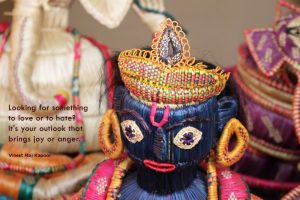
Some people try to showcase India as a risky place, even when the statistics point elsewhere. Playing the stereotype and raking up dust about India is so easy online. But parochial thought is not an India thing. “Trump that!”

Looking for something to love or to hate? It’s your outlook that brings joy or anger.
– Vineet Raj Kapoor
Let me explain how India handles gender and other issues. India does it for ages by having female deities in religion – like Kali, Saraswati, Laxmi. By travelling inside themselves like Buddha, Rama, Gandhi and others instead of travelling to conquer countries. By boldly handling sexuality in their art at Ajanta and Ellora as well as in paintings, unlike any other society. By focusing on humans in their movies instead of aliens and zombies. By electing females as their Prime Ministers and Presidents very early in the country’s life cycle. By living together and taking care of our children and parents – even sacrificing our careers for them and never talk about it.
And even in the festivals like “Kanjak” where we invite 7 little girls into our house with folded hands, wash their feet, pray before them (treat them at par with Goddess Kali), offer them food and gifts and take their blessings. Millions of families across India do this twice a year without questioning this practice as their sons watch and this is how gender sensitivity is transfered to the next generation. Another festival is “Rakhi” and another “Bhai Dooj” where brothers from around the world travel to their sister’s home (sometimes vice versa now) and take blessings from their sisters and offer them gifts.
 (notice all the adult hands guiding the customs
(notice all the adult hands guiding the customs
so that the children embrace them)
India follows all of it’s traditions and practices which imbibe these learnings into the next generation. Indians burn “Holika” and “Ravana” on Holi and Dussehra. India celebrates the story of Rama by dramatically reenacting it in “Ramlila” in 1000s of plays across the country leading to dussehra. India celebrates the return of “Rama” on Diwali. We still celebrate the sowing and reaping of crops on “Lohri” and “Baisakhi”, and add a dash of color on “Holi” where sometimes people are forced to participate in the festivity (the force of love) trying to take away their loneliness. Or even “Karva Chauth” when women fast and pray for the long life of their husbands. Even this is about woman, the wife, since the man must return home this day wherever in the world that he is.
Then there is the practice of “Langar” – offering free food to all. Maybe you already know that one such “Langar” at an ISKCON Temple in USA attracted Steve Jobs to learn more about India, and finally be at peace with himself and unleash his creative energies which were being held back by internal trauma.
Alongside, India celebrates Eid, Christmas, and all other religions. India also celebrates it’s animals by giving them the status of God. It’s no small matter that the largest population of Muslims in the world, lives in India and love this country. India has worked hard on this brotherhood, no point belittling it by pointing to incidents. Better ask the average person on the street and he’s happy living here.

India lives life by celebration
– Vineet Raj Kapoor
If you want to see and understand a country look at it’s beggars. In India, you’d see them as a community, laughing and sharing, whereas at some other places they are alone and lonely.
It’s all about training the mind. Whether you train it by logic or by practice. Whether you use the left brain or the right brain
